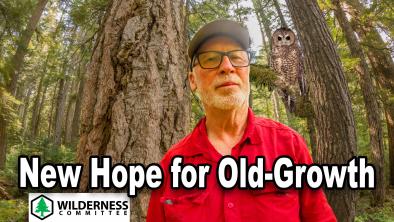Hope Never Dies - Wild Times

May 9th, 2009 - Read Joe Foy's Wild Times column in the Watershed Sentinel as he visits the brink of destruction in the Lillooet Valley.
In late April a friend and I drove up to the Lillooet Valley, north of Harrison Lake. This is the territory of the St’at’imc (pronounced Stat lee um) First Nation. On the way we camped for the night beside Lizzie Creek, a white water mountain stream whose valley and high alpine passes give access to the Stein Valley Heritage Park. My mood that night in camp see-sawed between the joy of once again being in a favourite wilderness area, and anger that Lizzie, like hundreds of other streams and rivers across the province had been staked by a private power company.
Concern over the proliferation of private power projects was what had brought us on this expedition.
We wanted to see what damage had been wrought on Lillooet River tributaries like Douglas Creek, Fire Creek and Tipella Creek by the construction of river diversion projects on them. I had visited these sites last spring and observed dirty muddy water pouring into one of the streams from construction. In the Douglas Creek valley, a huge swath of forest had been cut down in a spotted owl conservation area to allow the massive river diversion pipe to be buried in the ground.
After leaving our camp on the banks of Lizzie Creek, we drove down the Lillooet River Valley road along the shore of Lillooet Lake then down the valley into In Shuck Ch First Nation territory. The In’Shuck’Ch are St’at’imc speaking people. Their territory is perhaps the most beautiful of any I have seen – at least in my eyes it is.
We headed up to another favourite area of mine, Glacier Lake, part of the Snowcap Creek drainage. Glacier Lake borders Garibaldi Provincial Park and except for some logged over areas from the 80s and 90s, is for the most part surrounded by old growth forest. It’s a beauty of a watershed – and it’s been staked by a private company to be diverted into a big pipe to produce hydro power, just like Lizzie, Douglas, Fire and Tipella and hundreds of others.
After lunch on Glacier Lake, we headed down the Lillooet Valley, and at the base of Fire Mountain ran into a side road with an “active logging” sign at its entrance. My lunch now felt like a lump of lead in the pit of my stomach. Fire Mountain is home to some of the finest spotted owl recovery habitat left in southwest BC. The sign could only mean one thing. Environment Minster Barry Penner was up to his old “talk and log” tricks again.
Penner, the former parks ranger turned Environment Minister, lately had been talking a good game on endangered species protection. Environment Ministry officials had recently told us that the boundaries of spotted owl management areas were soon to be finalized and that areas of forest so designated would be off-limits to logging. When the Wilderness Committee first started working on this issue in the early 90s there were an estimated 100 spotted owls holding on to dear life in the forests of southwest BC. Today there are five remaining owls in the wild with another hand full cooped up in pens – part of the BC government’s attempt at captive breeding. If this last ditch effort at captive breeding actually produces chicks, Fire Mountain is one of the places that they will live. It’s faint hope – but at least it’s some kind of hope.
And Fire Mountain is a designated spotted owl management area – so what was the deal with the active logging sign, we wondered. We headed up the road – right smack into the middle of a chainsaw massacre of some of the last prime spotted owl recovery habitat left in Canada. There were big Douglas firs laid low everywhere we looked. The sweet smell of clearcut hung in the air. Fresh sawdust sifted down from the stumps, pushed by the mountain breeze. The slash of destruction went on for five kilometres up Fire Mountain. It was an active logging show, with more trees slated to come down further up slope.
It took us so long to document the destruction in photos and video clips on Fire Mountain, we never did get a chance to check out the river diversion projects up valley.
Heading home we made plans to set up yet another Wilderness Committee protest camp on the brink of destruction in the Lillooet Valley. I guess hope never dies until the last breath.


